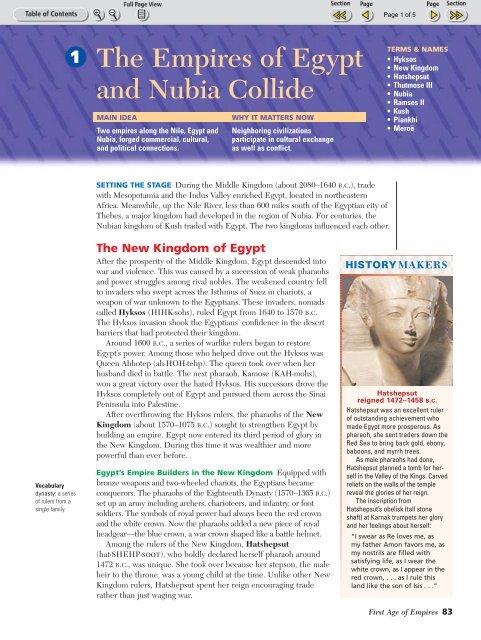The Empires of Egypt and Nubia Collide 1 - New Braunfels ISD
The Empires of Egypt and Nubia Collide 1 - New Braunfels ISD
The Empires of Egypt and Nubia Collide 1 - New Braunfels ISD
You also want an ePaper? Increase the reach of your titles
YUMPU automatically turns print PDFs into web optimized ePapers that Google loves.
083-87-0104s1 10/11/02 3:33 PM Page 83<br />
1<br />
Vocabulary<br />
dynasty: a series<br />
<strong>of</strong> rulers from a<br />
single family.<br />
<strong>The</strong> <strong>Empires</strong> <strong>of</strong> <strong>Egypt</strong><br />
<strong>and</strong> <strong>Nubia</strong> <strong>Collide</strong><br />
MAIN IDEA<br />
Two empires along the Nile, <strong>Egypt</strong> <strong>and</strong><br />
<strong>Nubia</strong>, forged commercial, cultural,<br />
<strong>and</strong> political connections.<br />
WHY IT MATTERS NOW<br />
Neighboring civilizations<br />
participate in cultural exchange<br />
as well as conflict.<br />
SETTING THE STAGE During the Middle Kingdom (about 2080–1640 B.C.), trade<br />
with Mesopotamia <strong>and</strong> the Indus Valley enriched <strong>Egypt</strong>, located in northeastern<br />
Africa. Meanwhile, up the Nile River, less than 600 miles south <strong>of</strong> the <strong>Egypt</strong>ian city <strong>of</strong><br />
<strong>The</strong>bes, a major kingdom had developed in the region <strong>of</strong> <strong>Nubia</strong>. For centuries, the<br />
<strong>Nubia</strong>n kingdom <strong>of</strong> Kush traded with <strong>Egypt</strong>. <strong>The</strong> two kingdoms influenced each other.<br />
<strong>The</strong> <strong>New</strong> Kingdom <strong>of</strong> <strong>Egypt</strong><br />
After the prosperity <strong>of</strong> the Middle Kingdom, <strong>Egypt</strong> descended into<br />
war <strong>and</strong> violence. This was caused by a succession <strong>of</strong> weak pharaohs<br />
<strong>and</strong> power struggles among rival nobles. <strong>The</strong> weakened country fell<br />
to invaders who swept across the Isthmus <strong>of</strong> Suez in chariots, a<br />
weapon <strong>of</strong> war unknown to the <strong>Egypt</strong>ians. <strong>The</strong>se invaders, nomads<br />
called Hyksos (HIHK •sohs), ruled <strong>Egypt</strong> from 1640 to 1570 B.C.<br />
<strong>The</strong> Hyksos invasion shook the <strong>Egypt</strong>ians’ confidence in the desert<br />
barriers that had protected their kingdom.<br />
Around 1600 B.C., a series <strong>of</strong> warlike rulers began to restore<br />
<strong>Egypt</strong>’s power. Among those who helped drive out the Hyksos was<br />
Queen Ahhotep (ah •HOH •tehp). <strong>The</strong> queen took over when her<br />
husb<strong>and</strong> died in battle. <strong>The</strong> next pharaoh, Kamose (KAH •mohs),<br />
won a great victory over the hated Hyksos. His successors drove the<br />
Hyksos completely out <strong>of</strong> <strong>Egypt</strong> <strong>and</strong> pursued them across the Sinai<br />
Peninsula into Palestine.<br />
After overthrowing the Hyksos rulers, the pharaohs <strong>of</strong> the <strong>New</strong><br />
Kingdom (about 1570–1075 B.C.) sought to strengthen <strong>Egypt</strong> by<br />
building an empire. <strong>Egypt</strong> now entered its third period <strong>of</strong> glory in<br />
the <strong>New</strong> Kingdom. During this time it was wealthier <strong>and</strong> more<br />
powerful than ever before.<br />
<strong>Egypt</strong>’s Empire Builders in the <strong>New</strong> Kingdom Equipped with<br />
bronze weapons <strong>and</strong> two-wheeled chariots, the <strong>Egypt</strong>ians became<br />
conquerors. <strong>The</strong> pharaohs <strong>of</strong> the Eighteenth Dynasty (1570–1365 B.C.)<br />
set up an army including archers, charioteers, <strong>and</strong> infantry, or foot<br />
soldiers. <strong>The</strong> symbols <strong>of</strong> royal power had always been the red crown<br />
<strong>and</strong> the white crown. Now the pharaohs added a new piece <strong>of</strong> royal<br />
headgear—the blue crown, a war crown shaped like a battle helmet.<br />
Among the rulers <strong>of</strong> the <strong>New</strong> Kingdom, Hatshepsut<br />
(hat •SHEHP •soot), who boldly declared herself pharaoh around<br />
1472 B.C., was unique. She took over because her stepson, the male<br />
heir to the throne, was a young child at the time. Unlike other <strong>New</strong><br />
Kingdom rulers, Hatshepsut spent her reign encouraging trade<br />
rather than just waging war.<br />
TERMS & NAMES<br />
• Hyksos<br />
• <strong>New</strong> Kingdom<br />
• Hatshepsut<br />
• Thutmose III<br />
• <strong>Nubia</strong><br />
• Ramses II<br />
• Kush<br />
• Piankhi<br />
• Meroë<br />
■ ■ ■ ■ ■ ■ ■ ■ ■ ■<br />
■HISTORYMAKERS ■ ■ ■ ■ ■ ■ ■ ■<br />
■ ■ ■ ■ ■ ■ ■ ■ ■ ■<br />
Hatshepsut<br />
reigned 1472–1458 B.C.<br />
Hatshepsut was an excellent ruler<br />
<strong>of</strong> outst<strong>and</strong>ing achievement who<br />
made <strong>Egypt</strong> more prosperous. As<br />
pharaoh, she sent traders down the<br />
Red Sea to bring back gold, ebony,<br />
baboons, <strong>and</strong> myrrh trees.<br />
As male pharaohs had done,<br />
Hatshepsut planned a tomb for herself<br />
in the Valley <strong>of</strong> the Kings. Carved<br />
reliefs on the walls <strong>of</strong> the temple<br />
reveal the glories <strong>of</strong> her reign.<br />
<strong>The</strong> inscription from<br />
Hatshepsut’s obelisk (tall stone<br />
shaft) at Karnak trumpets her glory<br />
<strong>and</strong> her feelings about herself:<br />
“I swear as Re loves me, as<br />
my father Amon favors me, as<br />
my nostrils are filled with<br />
satisfying life, as I wear the<br />
white crown, as I appear in the<br />
red crown, . . . as I rule this<br />
l<strong>and</strong> like the son <strong>of</strong> Isis . . .”<br />
First Age <strong>of</strong> <strong>Empires</strong> 83
083-87-0104s1 10/11/02 3:33 PM Page 84<br />
In this wall painting<br />
from an <strong>Egypt</strong>ian<br />
tomb, <strong>Nubia</strong>ns<br />
bring tribute to<br />
the pharaoh.<br />
84 Chapter 4<br />
Hatshepsut’s stepson, Thutmose III (thoot •MOH •suh), proved to be a much more<br />
warlike ruler. In fact, in his eagerness to ascend to the throne, Thutmose III<br />
may even have murdered his stepmother, Hatshepsut. Between the<br />
time he took power <strong>and</strong> his death around 1425 B.C., Thutmose III<br />
led a number <strong>of</strong> victorious invasions into Palestine <strong>and</strong> Syria.<br />
Under Thutmose’s rule, <strong>Egypt</strong>ian armies also pushed farther<br />
south into <strong>Nubia</strong>, a region <strong>of</strong> Africa that straddled the upper<br />
Nile River. From the Blue Nile, the southern boundary <strong>of</strong><br />
<strong>Nubia</strong>, to the shores <strong>of</strong> the Mediterranean was a distance <strong>of</strong><br />
approximately 1,000 miles. From <strong>Nubia</strong>, <strong>Egypt</strong>ian soldiers<br />
returned carrying gold, cattle, ivory, <strong>and</strong> many captives<br />
whom they enslaved. <strong>The</strong> destinies <strong>of</strong> <strong>Egypt</strong> <strong>and</strong> <strong>Nubia</strong><br />
would be connected for hundreds <strong>of</strong> years.<br />
<strong>Egypt</strong> was now a mighty empire. It controlled l<strong>and</strong>s<br />
around the Nile <strong>and</strong> far beyond. In addition, it drew boundless<br />
wealth from them. Contact with other cultures brought<br />
<strong>Egypt</strong> new ideas as well as material goods. <strong>Egypt</strong> had never<br />
before—nor has it since—comm<strong>and</strong>ed such power <strong>and</strong><br />
wealth as during the reigns <strong>of</strong> the <strong>New</strong> Kingdom pharaohs.<br />
<strong>The</strong> <strong>Egypt</strong>ians <strong>and</strong> the Hittites By about 1400 B.C.,<br />
<strong>Egypt</strong>ian armies had crossed the Sinai Peninsula <strong>and</strong> conquered<br />
parts <strong>of</strong> Syria <strong>and</strong> Palestine. <strong>The</strong>se conquests brought the <strong>Egypt</strong>ians into conflict with<br />
the Hittites. <strong>The</strong> Hittites had moved into Asia Minor around 1900 B.C. <strong>and</strong> later<br />
exp<strong>and</strong>ed southward into Palestine.<br />
After several battles, the <strong>Egypt</strong>ian <strong>and</strong> Hittite armies met at the Battle <strong>of</strong> Kadesh<br />
around 1285 B.C. <strong>The</strong>re the two armies fought each other to a st<strong>and</strong>still. <strong>The</strong> pharaoh,<br />
Ramses II (RAM •seez), <strong>and</strong> a Hittite king later made a treaty that promised “peace<br />
<strong>and</strong> brotherhood between us forever.” <strong>The</strong>ir alliance lasted for the rest <strong>of</strong> the century.<br />
An Age <strong>of</strong> Builders Like the Old Kingdom with its towering pyramids, rulers <strong>of</strong> the<br />
<strong>New</strong> Kingdom erected magnificent palaces, temples, <strong>and</strong> tombs. In search <strong>of</strong> security<br />
in the afterlife, they hid their splendid tombs beneath desert cliffs. In this way, they<br />
would not be plundered by grave robbers <strong>and</strong> looters. <strong>The</strong> site they chose was the<br />
remote Valley <strong>of</strong> the Kings near <strong>The</strong>bes. Besides royal tombs, the pharaohs <strong>of</strong> this<br />
period also built great palaces <strong>and</strong> magnificent temples. Indeed, the word pharaoh<br />
means “great house” <strong>and</strong> comes from this time period. <strong>The</strong> word became a royal title.<br />
Ramses II, whose reign extended from approximately 1290 to 1224 B.C., stood out<br />
among the great builders <strong>of</strong> the <strong>New</strong> Kingdom. He lived to the age <strong>of</strong> 99 <strong>and</strong> was the<br />
father <strong>of</strong> 150 children. At Karnak, he added to a monumental temple to Amon<br />
(AH•muhn), <strong>Egypt</strong>’s chief god. Ramses also ordered a temple to be carved into the<br />
red s<strong>and</strong>stone cliffs above the Nile River at Abu Simbel (AH•boo SIHM•buhl). <strong>Egypt</strong>’s<br />
last great pharaoh ordered these temples decorated with enormous statues <strong>of</strong> himself.<br />
<strong>The</strong> ears alone measured over three feet. Although these buildings are huge <strong>and</strong><br />
impressive, they were not as skillfully built as those <strong>of</strong> the Old Kingdom.<br />
<strong>The</strong> Empire Declines<br />
<strong>The</strong> empire that Thutmose III had built <strong>and</strong> Ramses II had ruled came apart slowly<br />
after 1200 B.C. as other strong civilizations rose to challenge <strong>Egypt</strong>’s power. Shortly<br />
after Ramses died, the entire eastern Mediterranean suffered a wave <strong>of</strong> invasions<br />
around 1200 B.C. <strong>The</strong>se invasions destroyed many kingdoms.<br />
Invasions by L<strong>and</strong> <strong>and</strong> Sea Both the <strong>Egypt</strong>ian empire <strong>and</strong> the Hittite kingdom<br />
were attacked by “the People <strong>of</strong> the Sea.” Scholars have not conclusively identified<br />
these invaders, although they may well have been the Philistines <strong>of</strong>ten mentioned<br />
THINK THROUGH HISTORY<br />
A. Recognizing<br />
Effects What were<br />
some <strong>of</strong> the political<br />
<strong>and</strong> economic effects<br />
<strong>of</strong> <strong>Egypt</strong>’s conquests?<br />
A. Possible Answer<br />
Conquest brought<br />
<strong>Egypt</strong> riches <strong>and</strong><br />
cultural influences;<br />
it also brought conflict<br />
with conquered<br />
peoples.<br />
Background <strong>The</strong><br />
word pharaoh became<br />
a royal title because<br />
the ruler’s own name<br />
was considered too<br />
sacred to use.
083-87-0104s1 10/11/02 3:33 PM Page 85<br />
20°E<br />
Mediterranean Sea<br />
WESTERN<br />
DESERT<br />
0<br />
0<br />
Kush Empire<br />
(at its greatest extent)<br />
<strong>Egypt</strong>ian Empire<br />
(at its greatest extent)<br />
cataract<br />
in the Bible. Whoever they were, the People <strong>of</strong> the Sea caused great destruction.<br />
From the east, the tribes <strong>of</strong> Palestine <strong>of</strong>ten rebelled against their <strong>Egypt</strong>ian<br />
overlords. From the west, even the vast desert no longer stopped Libyans from<br />
raiding <strong>Egypt</strong>ian villages.<br />
<strong>Egypt</strong>’s Empire Fades After these invasions, <strong>Egypt</strong> never recovered its previous<br />
power. <strong>Egypt</strong> broke apart into regional units. Isolated rural populations erected their<br />
own walled defenses. In <strong>Egypt</strong>’s former empire numerous small kingdoms arose.<br />
Each was eager to protect its independence. As the empire faded to a distant memory,<br />
princes <strong>of</strong> these small kingdoms treated <strong>Egypt</strong>ian <strong>of</strong>ficials with contempt.<br />
Powerless at home <strong>and</strong> abroad, <strong>Egypt</strong> fell to its neighbors’ invasions. Libyans<br />
crossed the desert to the Nile delta. <strong>The</strong>re they established independent dynasties.<br />
From 950 to 730 B.C., Libyan pharaohs ruled <strong>Egypt</strong> <strong>and</strong> erected cities. Far from<br />
imposing their own culture, the Libyans embraced the <strong>Egypt</strong>ian way <strong>of</strong> life. When<br />
the <strong>Nubia</strong>ns came north to seize power, they, too, would adopt the <strong>Egypt</strong>ian religion,<br />
manners, <strong>and</strong> culture.<br />
<strong>The</strong> Kushites Conquer the Nile Region<br />
For centuries, <strong>Nubia</strong>, the area along the upper Nile River south <strong>of</strong> <strong>Egypt</strong>, had been a<br />
source <strong>of</strong> products <strong>and</strong> slaves for <strong>Egypt</strong>. <strong>Egypt</strong>’s domination <strong>of</strong> <strong>Nubia</strong> <strong>and</strong> the <strong>Nubia</strong>n<br />
kingdom <strong>of</strong> Kush lasted for about a thous<strong>and</strong> years, between 2000 B.C. <strong>and</strong> 1000 B.C.<br />
During this time, <strong>Egypt</strong>ian armies raided <strong>and</strong> even occupied Kush for a brief period.<br />
But as <strong>Egypt</strong> fell into decline around 1000 B.C., Kush was emerging as a regional<br />
power. <strong>Nubia</strong> would now establish its own Kushite dynasty on the<br />
throne <strong>of</strong> <strong>Egypt</strong>.<br />
Kush Empire, 700 B.C.<br />
30°E<br />
LOWER Memphis<br />
EGYPT<br />
UPPER<br />
EGYPT<br />
500 Miles<br />
N i l e R i ver<br />
Napata<br />
NUBIA<br />
1,000 Kilometers<br />
<strong>The</strong>bes<br />
White Nile<br />
Blue<br />
R e d S e a<br />
Meroë<br />
Nile<br />
40°E<br />
ARABIAN<br />
DESERT<br />
30°N<br />
Tropic <strong>of</strong> Cancer<br />
20°N<br />
GEOGRAPHY SKILLBUILDER: Interpreting Maps<br />
1. Place What l<strong>and</strong>form to the west <strong>of</strong> the Nile might have<br />
prevented the <strong>Egypt</strong>ian <strong>and</strong> Kush empires from exp<strong>and</strong>ing in<br />
that direction?<br />
2. Region Compare the size <strong>of</strong> the Kush <strong>and</strong> <strong>Egypt</strong>ian empires.<br />
Which was larger, <strong>and</strong> why?<br />
10°N<br />
Napata, the capital <strong>of</strong> Kush, was a center <strong>of</strong> trade in<br />
the <strong>Nubia</strong>n <strong>and</strong> <strong>Egypt</strong>ian empires. Goods traded in<br />
Napata included pottery such as the vessel with<br />
giraffes shown above. This jug was probably used<br />
for wine storage.<br />
First Age <strong>of</strong> <strong>Empires</strong> 85
083-87-0104s1 10/11/02 3:33 PM Page 86<br />
Granite sculpture <strong>of</strong> Amenemhat III <strong>of</strong><br />
<strong>Egypt</strong> as a sphinx dates back to the<br />
Twelfth Dynasty, 1844–1797 B.C.<br />
86 Chapter 4<br />
<strong>The</strong> People <strong>of</strong> <strong>Nubia</strong> <strong>Nubia</strong> lay south <strong>of</strong> <strong>Egypt</strong> between the first cataract <strong>of</strong> the Nile<br />
<strong>and</strong> the division <strong>of</strong> the river into the Blue <strong>and</strong> White Niles. Despite several cataracts<br />
around which boats had to be carried, the lengthy Nile provided the best north-south<br />
trade route. Several <strong>Nubia</strong>n kingdoms (including Kush) served as a trade corridor.<br />
<strong>The</strong>y linked <strong>Egypt</strong> <strong>and</strong> the Mediterranean world to the north with the interior <strong>of</strong><br />
Africa to the south <strong>and</strong> to the Red Sea. Along the river, goods <strong>and</strong> ideas flowed back<br />
<strong>and</strong> forth for centuries. <strong>The</strong> first <strong>Nubia</strong>n kingdom, Kerma, arose shortly after 2000<br />
b.c. Kerma’s kings were buried in chambers larger than those in any <strong>Egypt</strong>ian pyramid.<br />
Red-<strong>and</strong>-black Kerma pottery <strong>of</strong> great beauty fetched high prices from <strong>Egypt</strong>ian<br />
nobles. Kerma prospered during <strong>Egypt</strong>’s Hyksos period.<br />
<strong>The</strong> Interaction <strong>of</strong> <strong>Egypt</strong> <strong>and</strong> <strong>Nubia</strong> With <strong>Egypt</strong>’s revival during the <strong>New</strong> Kingdom,<br />
pharaohs forcefully imposed <strong>Egypt</strong>ian rule on <strong>Nubia</strong>’s next great kingdom, Kush. During a<br />
long period, <strong>Egypt</strong> ruled Kush. <strong>Egypt</strong>ian governors, priests, soldiers, <strong>and</strong> artists strongly<br />
influenced the <strong>Nubia</strong>ns. Indeed, Kush’s capital, Napata, became the center for the spread<br />
<strong>of</strong> <strong>Egypt</strong>ian culture to Kush’s other African trading partners.<br />
Kushite princes went to <strong>Egypt</strong>. <strong>The</strong>y learned the <strong>Egypt</strong>ian language <strong>and</strong> worshiped<br />
<strong>Egypt</strong>ian gods. <strong>The</strong>y adopted the customs <strong>and</strong> clothing styles <strong>of</strong> the <strong>Egypt</strong>ian upper class.<br />
When they returned home, the Kushite nobles brought back royal rituals <strong>and</strong> hieroglyphic<br />
writing. <strong>The</strong>y built pyramids based on <strong>Egypt</strong>ian models, but with steeper sides.<br />
With <strong>Egypt</strong>’s decline, beginning about 1100 B.C., Kush regained its independence.<br />
<strong>The</strong> Kushites viewed themselves as the guardians <strong>of</strong> <strong>Egypt</strong>ian values. <strong>The</strong>y sought to<br />
restore the <strong>Egypt</strong>ian way <strong>of</strong> life. <strong>The</strong>y tried to do this by conquering <strong>Egypt</strong> <strong>and</strong> ousting<br />
its Libyan rulers.<br />
Piankhi Captures the <strong>Egypt</strong>ian Throne In 751 B.C., a Kushite king named<br />
Piankhi led an army down the Nile <strong>and</strong> overthrew the Libyan dynasty that had ruled<br />
<strong>Egypt</strong> for over 200 years. He united the entire Nile Valley from the delta in the north to<br />
Napata in the south. Piankhi <strong>and</strong> his descendants became <strong>Egypt</strong>’s Twenty-fifth Dynasty.<br />
After his victory, Piankhi erected a monument in his homel<strong>and</strong> <strong>of</strong> Kush. It tells the story<br />
<strong>of</strong> his military triumph, which he viewed as the restoration <strong>of</strong> <strong>Egypt</strong>’s glory.<br />
HISTORY THROUGH ART: Sculpture<br />
<strong>The</strong> interaction <strong>of</strong> <strong>Egypt</strong> <strong>and</strong> <strong>Nubia</strong><br />
can be seen in the art <strong>and</strong> sculpture<br />
<strong>of</strong> the two kingdoms. <strong>The</strong> portrait <strong>of</strong><br />
the <strong>Egypt</strong>ian pharaoh to the left is<br />
over a thous<strong>and</strong> years older than<br />
that <strong>of</strong> the <strong>Nubia</strong>n king to the right.<br />
Connect to History<br />
Comparing What similarities<br />
can you see between the two<br />
portraits? What qualities do they<br />
suggest in the rulers?<br />
SEE SKILLBUILDER<br />
HANDBOOK, PAGE R7<br />
Connect to Today<br />
Planning a Portrait What are<br />
some elements that you would<br />
include in a portrait <strong>of</strong> a powerful<br />
person in today’s society?<br />
This granite sphinx <strong>of</strong> King Taharqa <strong>of</strong><br />
<strong>Nubia</strong> comes from the Amon Temple at<br />
Kawa, 690–664 B.C.<br />
THINK THROUGH HISTORY<br />
B. Making<br />
Inferences Why<br />
might the Kushites<br />
have viewed themselves<br />
as guardians<br />
<strong>of</strong> <strong>Egypt</strong>ian values?<br />
B. Possible Answer<br />
For centuries,<br />
<strong>Nubia</strong>n nobles<br />
received their education<br />
in <strong>Egypt</strong>.<br />
When they returned<br />
home, they carried<br />
back <strong>Egypt</strong>ian<br />
styles <strong>and</strong> ideas,<br />
which strongly<br />
influenced <strong>Nubia</strong>n<br />
culture.
083-87-0104s1 10/11/02 3:33 PM Page 87<br />
Background<br />
<strong>The</strong> use <strong>of</strong> iron<br />
weapons favored<br />
people who could<br />
forge iron <strong>and</strong> paved<br />
the way for an age<br />
<strong>of</strong> empires.<br />
1. TERMS & NAMES<br />
Identify<br />
• Hyksos<br />
• <strong>New</strong> Kingdom<br />
• Hatshepsut<br />
• Thutmose III<br />
• <strong>Nubia</strong><br />
• Ramses II<br />
• Kush<br />
• Piankhi<br />
• Meroë<br />
On the monument he had words inscribed that celebrated his victory. <strong>The</strong> inscription<br />
provided a catalog <strong>of</strong> the riches <strong>of</strong> the north, including those <strong>of</strong> <strong>Egypt</strong> <strong>and</strong> Syria:<br />
A VOICE FROM THE PAST<br />
<strong>The</strong>n the ships were laden with silver, gold, copper, clothing, <strong>and</strong> everything <strong>of</strong> the<br />
Northl<strong>and</strong>, every product <strong>of</strong> Syria <strong>and</strong> all sweet woods <strong>of</strong> God’s-L<strong>and</strong>. His Majesty sailed<br />
upstream [south], with glad heart, the shores on his either side were jubilating. West<br />
<strong>and</strong> east were jubilating in the presence <strong>of</strong> His Majesty.<br />
PIANKHI, monument in Cairo Museum<br />
However, Piankhi’s dynasty proved short-lived. In 671 B.C., the Assyrians, a warlike<br />
people from Southwest Asia, conquered <strong>Egypt</strong>. <strong>The</strong> Kushites fought bravely, but they<br />
were forced to retreat south up the Nile by the Assyrians. <strong>The</strong>re the Kushites would<br />
experience a golden age, despite their loss <strong>of</strong> <strong>Egypt</strong>.<br />
<strong>The</strong> Golden Age <strong>of</strong> Meroë<br />
After their defeat by the Assyrians, the Kushite royal family<br />
eventually moved south to Meroë (MEHR •oh •ee). Far<br />
enough away from <strong>Egypt</strong> to provide security, Meroë lay<br />
closer to the Red Sea than Napata did. It became active<br />
in the booming trade between Africa, Arabia, <strong>and</strong> India.<br />
<strong>The</strong> Wealth <strong>of</strong> Kush It was here that Kush made use <strong>of</strong><br />
rich natural resources to thrive independently <strong>of</strong> <strong>Egypt</strong> for<br />
several hundred years. Unlike <strong>Egypt</strong>ian cities along the Nile,<br />
Meroë enjoyed significant rainfall. And, unlike <strong>Egypt</strong>, Meroë boasted<br />
abundant supplies <strong>of</strong> iron ore. Meroë became a major center for the manufacture <strong>of</strong><br />
iron weapons <strong>and</strong> tools.<br />
In Meroë, ambitious merchants loaded iron bars, tools, <strong>and</strong> spearheads onto their<br />
donkeys. <strong>The</strong>y then transported the goods to the Red Sea, where they exchanged these<br />
goods for jewelry, fine cotton cloth, silver lamps, <strong>and</strong> glass bottles. As the mineral<br />
wealth <strong>of</strong> the central Nile valley flowed out <strong>of</strong> Meroë, luxury goods from India <strong>and</strong><br />
Arabia flowed in. <strong>The</strong> Kushite kings lived like pharaohs, ruling from palaces <strong>and</strong> spending<br />
the afterlife in splendid stone-faced pyramids. Unlike the <strong>Egypt</strong>ian pharaohs, their<br />
succession was determined by the agreement <strong>of</strong> the leaders <strong>and</strong> nobles.<br />
<strong>The</strong> Decline <strong>of</strong> Meroë After four centuries <strong>of</strong> prosperity, from about 250 B.C. to<br />
A.D. 150, Meroë began to decline. <strong>The</strong> rise <strong>of</strong> Aksum, a rival power located 400 miles<br />
southeast, contributed to Meroë’s fall. With a seaport along the Red Sea, Aksum now<br />
dominated North African trade. Aksum defeated Meroë around A.D. 350.<br />
Centuries earlier, around the time the Kushite pharaoh sat on <strong>Egypt</strong>’s throne, a new<br />
empire had gathered in the north. Like Kush, Assyria would come to dominate <strong>Egypt</strong>.<br />
2. TAKING NOTES<br />
Create a time line showing<br />
important events in the history <strong>of</strong><br />
<strong>Egypt</strong> <strong>and</strong> Kush.<br />
1570 B.C. A.D. 350<br />
<strong>Egypt</strong>ian<br />
<strong>New</strong><br />
Kingdom<br />
Which empire was invaded more<br />
<strong>of</strong>ten? Why?<br />
Section 1 Assessment<br />
Aksum<br />
defeats<br />
Meroë<br />
3. RECOGNIZING BIAS<br />
Read the temple inscription<br />
written by Piankhi <strong>and</strong> quoted at<br />
the top <strong>of</strong> this page. Explain how<br />
an <strong>Egypt</strong>ian might have written<br />
the inscription differently.<br />
THINK ABOUT<br />
• what bias Piankhi had<br />
• how <strong>Egypt</strong>ians benefited from<br />
Piankhi’s invasion<br />
• why <strong>Egypt</strong>ians might have<br />
disagreed with Piankhi<br />
This armlet dates<br />
from Meroë in the<br />
late first century<br />
B.C. It is made <strong>of</strong><br />
gold with fusedglass<br />
inlays. On the<br />
hinge is a goddess<br />
wearing a vulture<br />
headdress <strong>and</strong> a<br />
double crown.<br />
4. ANALYZING THEMES<br />
Empire Building How did<br />
<strong>Egypt</strong> <strong>and</strong> <strong>Nubia</strong> strengthen each<br />
other at various times in their<br />
histories?<br />
THINK ABOUT<br />
• the role <strong>of</strong> trade <strong>and</strong> the<br />
movement <strong>of</strong> goods<br />
• the impact <strong>of</strong> military<br />
movements<br />
• the influence <strong>of</strong> cultural<br />
developments<br />
First Age <strong>of</strong> <strong>Empires</strong> 87

















